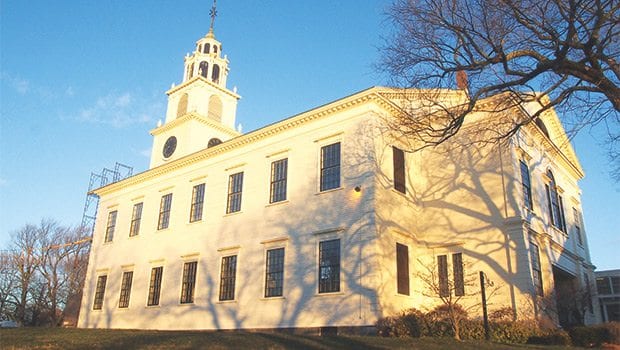
For decades the First Church of Roxbury has worn coats of snow-white paint, matching other federal style historic meeting houses in Dorchester and cities and towns throughout New England.
All that changed this year, though, when a preservationist applied an historically correct shade of white that more accurately approximates what was available when the church was constructed in 1804: a cream-colored hue with a slightly yellow tint.
Would the new (old) color ruffle the feathers of Roxbury residents who, in the New England fashion, are resistant to change? Not really, according to Mary Margaret Earl, executive director of the Unitarian Universalist Urban Ministry, which is housed in the rectory adjoining the historic church.
“People either say they like the color, or they ask about the color,” she said. “They’re happy to hear it’s a historically more authentic color.”
Architectural conservator Andrea Gilmore chose the color from the Benjamin Moore palette, after sifting through 200 years of paint layers to find the original 1804 color. While modern paints use latex and synthetic oil polymers, paint at the turn of the 19th century relied on linseed oil.
“It has a warmer color,” Gilmore said. “Historically, it would have been considered white.”
While most of the building was stripped of its original layers of paint, Gilmore said she left a small section intact.
“We preserved a section of the building where the full sequence of paint from the last 200 years is present,” she said.
Those layers include gray and yellow shades the building wore in the 1800s before it was returned to white in the early 1900s.
Earl is in the midst of a funding drive to raise $3 million to renovate the First Church. The nearly-finished exterior renovations, which included replacement of window shutters and small sections of rotting wood, is projected to cost $800,000.
Interior renovations will include painting, plastering and repairs or replacement of the seating, which currently is in box pews, some of which have tattered upholstery. Repairs to the building’s heating system were made last year. The organ was partially restored and can be played, although it does not have full functionality. Last week, the four-faced clock in the steeple tower was brought back to life. The Urban Ministry will celebrate the rehabilitation of the clock with a public event in early January, Earl said.
One part of the church that did not require renovations is the 1,500-pound bell, cast by Paul Revere’s foundry, which still rings from its perch in the steeple with a tug of a 50-foot-long rope.
The physical rehabilitation of the building is happening as the meetinghouse opens its doors to a wider range of programming. Earl envisions the church as a site for concerts and forums. In November, the church was host to a concert by the Handel and Haydn Society, titled “Requiem for Division.” Baroque music was interspersed with references to black history and the history of the First Church, including James Weldon Johnson’s “Lift Every Voice and Sing” and “Garrison” a poem that was read at the 1879 funeral of former parishioner William Lloyd Garrison. Local luminaries such as Angela Page, Joe Cook and Tito Jackson participated in the poetry readings.
Earl says the expanded programming is in keeping with the church building’s history as a meetinghouse for the Roxbury community.
“We want it to be alive with many events that serve the community, including interfaith dialogues, political debate and cultural performances,” she said.
On Jan. 15, the meetinghouse will host a concert titled “Ties That Bind,” in honor of Martin Luther King Jr. Day. The program will include dance and poetry recitals.
The fifth meetinghouse
The current meetinghouse, built in 1804, is the fifth house of worship built on the site since the Puritan founders of Roxbury erected the first church there in 1632.
The First Church currently does not host religious services, but serves as the headquarters for the Unitarian Universalist Urban Ministries, a nonprofit agency that provides enrichment services for youth, emergency housing for families and other community services.
For many Roxbury residents the church, with its imposing steeple visible for miles, is a reminder of the history of the Puritan settlement.
“It’s our history,” says Dudley Square Main Streets Director Joyce Stanley, who lives in the Fort Hill section of Roxbury where the church is sited. “It’s a gorgeous building. The clock, the organ the bell, they’re all historic. It’s an important part of our community and our history.”
Gilmore, who has worked on similar meeting houses throughout New England over the last 40 years, said she finds Roxbury’s First Church stunning.
“It takes my breath away every time I come into Eliot Square,” she said.


![Banner [Virtual] Art Gallery](https://baystatebanner.com/wp-content/uploads/2024/04/Cagen-Luse_Men-at-store-e1713991226112-150x150.jpg)



